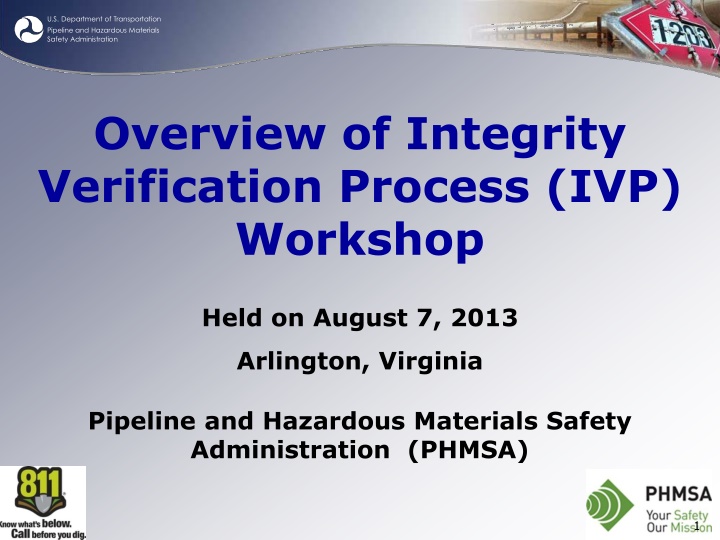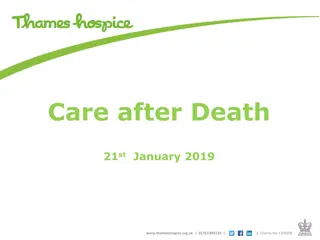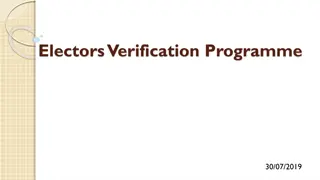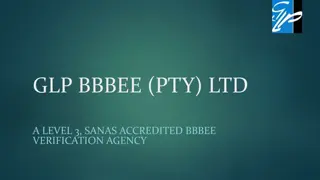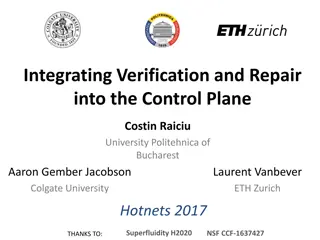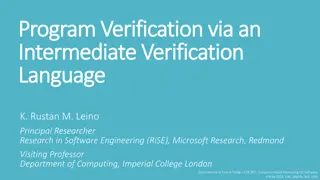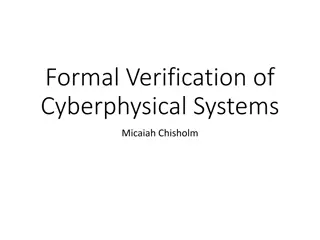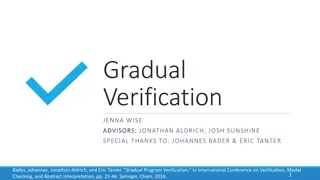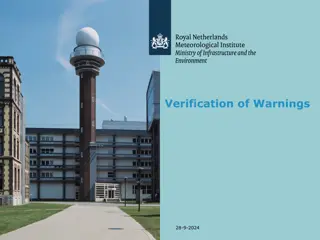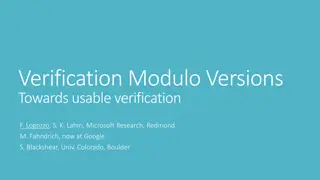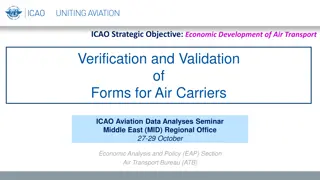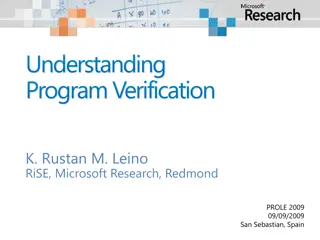Overview of Integrity Verification Process Workshop
Department of Transportation Pipeline and Hazardous Materials Safety Administration held a workshop on Integrity Verification Process, addressing congressional mandates and NTSB recommendations for pipeline integrity. The workshop covered topics like grandfathered pipes, testing regulations, and establishing a comprehensive program for pipeline integrity verification.
Download Presentation

Please find below an Image/Link to download the presentation.
The content on the website is provided AS IS for your information and personal use only. It may not be sold, licensed, or shared on other websites without obtaining consent from the author.If you encounter any issues during the download, it is possible that the publisher has removed the file from their server.
You are allowed to download the files provided on this website for personal or commercial use, subject to the condition that they are used lawfully. All files are the property of their respective owners.
The content on the website is provided AS IS for your information and personal use only. It may not be sold, licensed, or shared on other websites without obtaining consent from the author.
E N D
Presentation Transcript
U.S. Department of Transportation Pipeline and Hazardous Materials Safety Administration Overview of Integrity Verification Process (IVP) Workshop Held on August 7, 2013 Arlington, Virginia Pipeline and Hazardous Materials Safety Administration (PHMSA) 1
U.S. Department of Transportation Pipeline and Hazardous Materials Safety Administration Overview Attendance - + 220 at Westin Webcast Link to Workshop and Presentations http://primis.phmsa.dot.gov/meetings/MtgHome.mtg?mt g=91 Speakers NTSB Vice Chairman Chris Hart PHMSA Pipeline Safety Trust NAPSR Operators Gas and Liquids Intrastate (2) PG&E and Northwest Natural Gas Interstate INGAA Liquids API/AOPL Explorer Pipeline - 2 -
U.S. Department of Transportation Pipeline and Hazardous Materials Safety Administration Grandfathered Pipe & Related Issues PSA of 2011 - 23(a) 60139(d) mandate Testing Regulations - pressure testing or alternative equivalent means such as ILI program for all Gas Transmission pipe (Class 3, 4 and all HCAs) not previously tested; NTSB P-11-14 Delete Grandfather Clause - recommends all grandfathered pipe be pressured tested, including a spike test; NTSB P-11-15 Seam Stability - recommends pressure test to 1.25 x MAOP before treating latent manufacturing and construction defects as stable. NTSB P-11-17 Piggable Lines - Configure all lines to accommodate smart pigs, with priority given to older lines 3
U.S. Department of Transportation Pipeline and Hazardous Materials Safety Administration Integrity Verification GOAL: Establish a comprehensive program to effectively address a number of Congressional Mandates and NTSB Recommendations. Multi-disciplinary engineering approach has been defined to verify that steel gas transmission (GT) pipeline integrity is adequate for continued operation for some desired future period. 4
U.S. Department of Transportation Pipeline and Hazardous Materials Safety Administration Basic Principles of IVP Approach IVP is based on 4 principles 1. Apply to higher risk locations High Consequence Areas (HCAs) and Moderate Consequence Areas (MCAs) 2. Screen segments for categories of concern (e.g., Grandfathered segments) 3. Assure adequate material and documentation 4. Perform assessments to establish MAOP 5
U.S. Department of Transportation Pipeline and Hazardous Materials Safety Administration Principle #1 Apply to Higher Risk Locations High Consequence Areas (HCAs) Moderate Consequence Area (MCA): Non-HCA pipe in Class 2, 3, and 4 locations Non-HCA pipe Class 1 locations that are populated in PIR (proposed 1 house or occupied site) to align with INGAA commitment House count and occupied site definition same as HCA, except for 1 house or 1 person at a site (instead of 20) PHMSA Estimates 91,000 miles HCA/MCA (out of 300,000 miles) 6
U.S. Department of Transportation Pipeline and Hazardous Materials Safety Administration HCAs and Est. MCA Mileage Scope of Proposed IVP Process Estimated to Apply to: Total Estimated HCA + MCA Mileage = 91,000 miles Total 237,756 HCA 1,660 Non-HCA 236,096 (est.) 25,394 MCA Class 1 Class 2 28,798 28,798 30,210 1,412 Class 3 16,759 16,759 32,613 15,854 Class 4 209 209 962 752 Total 301,540 281,862 (est.) 71,160 19,678 PHMSA estimates approximately 33,000 miles of GT pipe (approximately 11% of total GT mileage) would meet screening criteria & require IVP assessment to establish MAOP IVP Process Steps 1 12 based upon 2012 Annual Report Data. 7
U.S. Department of Transportation Pipeline and Hazardous Materials Safety Administration Principle #2 Screen for Categories of Concern Apply process to pipeline segments with: Grandfathered Pipe Lack of Records to Substantiate MAOP Lack of Adequate Pressure Test Operating pressures over 72% SMYS (pre-Code) History of Failures Attributable to M&C Defects 8
U.S. Department of Transportation Pipeline and Hazardous Materials Safety Administration Principle #3 Know & Document Pipe Material If Missing or Inadequate Validated Traceable Material Documentation, then Establish Material Properties by an approved process: Cut out and Test Pipe Samples (Code approved process) In Situ Non-Destructive Testing (if validated and Code approved) Field verification of code stamp for components such as valves, flanges, and fabrications Other verifications 9
U.S. Department of Transportation Pipeline and Hazardous Materials Safety Administration Principle #4 Assessments to Establish MAOP Allow Operator to Select Best Option to Establish MAOP Candidate IVP Options for Establishing MAOP Subpart J Test with Spike Test Derate pressure Engineering Critical Assessment Replace Other options PHMSA should consider? 10
U.S. Department of Transportation Pipeline and Hazardous Materials Safety Administration Integrity Verification Process (IVP) Chart 11
U.S. Department of Transportation Pipeline and Hazardous Materials Safety Administration Draft - Process Steps 21 Step Process Grandfather Clause and MAOP Review Process Steps 1 4 Integrity Review Process Steps 5 8 Low Stress Review Process Steps 9 12 Material Documentation Review Process Steps 13 15 Assessment and Analysis Review Process Steps 16 20 Implementation Process Step 21 Deadlines for Implementation - 12 -
U.S. Department of Transportation Pipeline and Hazardous Materials Safety Administration Draft Process Step 9 HCA/MCA Screen A major screening criterion is location risk (HCA or MCA) Even though listed on the draft flow chart as Step 9, the HCA/MCA screening step may be accomplished first. HCA/MCA screen should be done first to avoid exhaustive and expensive documentation review for segments that are screened out by virtue of low location risk PHMSA Estimates 91,000 miles HCA/MCA miles (out of 300,000) 9 Segment in HCA or MCA? 13
U.S. Department of Transportation Pipeline and Hazardous Materials Safety Administration Assessment & Analysis - Steps 15-21 Assessment and Analysis to Establish Material Condition of Pipeline and MAOP, commensurate with segment-specific issues and documentation shortcomings. Assessment could include, as appropriate, specific assessments such as: ILI Program CIS Coating Survey Interference Survey Engineering Critical Assessment 15 19 Based on Results Take Appropriate Action to Est. MAOP Select Method to Establish MAOP Develop Specific Guidelines 18 Develop Specific Guidelines 17 Derate Pipeline 16 Document Basis for MAOP and Perform Remaining Life Fatigue Analysis Commensurate with Class Location And Perform Remaining Life Fatigue Analysis. Future Uprating allowed per Subpart K OR Replace Pipe Perform Subpart J Pressure Test Supplemented with Spike Pressure per NTSB P-11-14 20 Develop Specific Guidelines Develop Specific Guidelines Continue to Operate and Maintain in Accordance with Part 192 Develop Specific Guidelines 14 21 21
U.S. Department of Transportation Pipeline and Hazardous Materials Safety Administration Specific Guidelines & Criteria IVP Chart is high level concept Details and specifications under development Will use knowledge from workshop and comments on web site to develop details For Example: Spike pressure test specs (pressure, hold time, etc.) De-rate criteria (amount of MAOP reduction) ILI program requirements and specifications Material verification specs (# of cutouts, etc.) - 15 -
U.S. Department of Transportation Pipeline and Hazardous Materials Safety Administration Target Completion Timeframes Implementation Timeframe Multi-Year Effort Graduated timeframes with priority to: Legacy pipe segments HCAs High Stress segments Proposed deadlines under development Reasonableness in light of 2012 Annual Report data and estimated scope 16
U.S. Department of Transportation Pipeline and Hazardous Materials Safety Administration Thank you Steve Nanney US DOT / PHMSA (713) 272-2855 office steve.nanney@dot.gov 17
